Roadrunner Transportation Bundle
Who Are Roadrunner Transportation Company's Ideal Customers?
In the fast-paced world of logistics, understanding your customer is the key to survival and growth. This is especially true for Roadrunner Transportation SWOT Analysis, a shipping company that has redefined itself after a period of significant change. This article dives deep into the customer demographics and target market of Roadrunner Transportation Company, revealing the core of its strategic shift and future success. By analyzing its customer profile, we uncover the driving forces behind its market positioning.
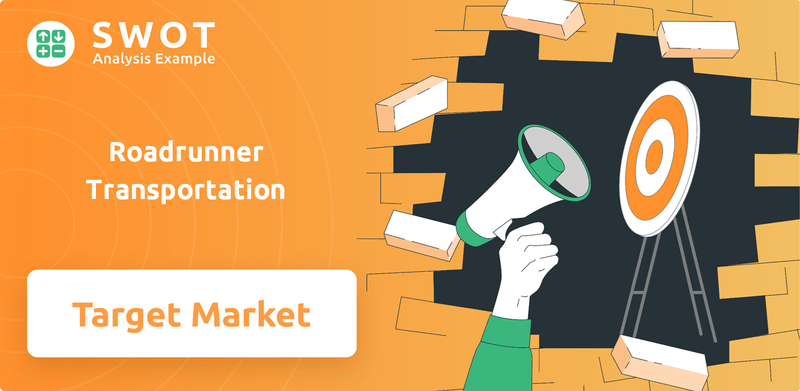
This market analysis will explore the specific needs and preferences of Roadrunner Transportation Company's clients, providing insights into their buying behavior and service expectations. We'll examine the age range, income levels, and geographic locations of its customers, offering a comprehensive view of its customer segmentation. Furthermore, we'll consider Roadrunner's customer acquisition strategy and competitive analysis to understand how it aims to satisfy its target audience and maintain its market share in the demanding transportation industry.
Who Are Roadrunner Transportation’s Main Customers?
The primary customer segments for Roadrunner Transportation Company are businesses (B2B) requiring trucking, less-than-truckload (LTL), and logistics services across North America. Their focus is on shippers who need flexible and dependable transportation, particularly for long-haul and time-sensitive freight. This customer profile is shaped by operational needs and industry demands rather than traditional demographic factors like age or income.
Roadrunner's LTL network is strategically positioned to handle cross-border shipping, especially for sectors such as manufacturing, distribution, e-commerce, and retail, with a strong emphasis on importers from Mexico. The company's approach involves direct, metro-to-metro LTL shipping, which reduces handling and enhances delivery speed and reliability. This strategy has been a key element in attracting customers who prioritize efficiency and minimizing freight damage.
Roadrunner has significantly expanded its network since 2019, adding a substantial number of new lanes. This growth strategy is focused on serving a broader range of businesses with long-haul LTL requirements. In 2024, Roadrunner's revenue was approximately $450 million, and the company was projected to be EBIT positive, indicating successful growth within its target segments.
Roadrunner's target market consists of businesses that require reliable and efficient shipping solutions. The company focuses on serving shippers with long-haul and time-sensitive freight needs. Their services cater to a diverse range of industries, including manufacturing, e-commerce, and retail.
Roadrunner offers truckload, less-than-truckload (LTL), and logistics services. Their LTL network specializes in cross-border shipping, particularly for importers from Mexico. The company's focus on direct, metro-to-metro LTL shipping enhances delivery speed and reduces freight damage.
Roadrunner has expanded its network by adding new lanes, including a significant number of '1,000+ Mile Power Lanes'. This expansion strategy targets key markets across the U.S., Canada, and Mexico. The company's growth is supported by a focus on efficiency and customer satisfaction.
In 2024, Roadrunner's revenue was approximately $450 million. The company was projected to be EBIT positive for the year. This financial performance indicates a successful turnaround and growth within its target segments, reflecting the effectiveness of its strategic initiatives.
Roadrunner's strategic focus on direct, metro-to-metro LTL shipping has allowed them to attract customers who value efficiency and reduced freight damage. The company's expansion into new lanes, with 135 new lanes added in 2024 and an additional 278 lanes by March 2025, demonstrates a commitment to serving a broader customer base. This growth is supported by investments in network, infrastructure, technology, and operations.
- Focus on B2B customers needing trucking, LTL, and logistics.
- Expansion into key markets like Portland, Toronto, and Montreal.
- Emphasis on efficient, reliable, and time-sensitive freight services.
- Financial success with $450 million revenue in 2024.
Roadrunner Transportation SWOT Analysis
- Complete SWOT Breakdown
- Fully Customizable
- Editable in Excel & Word
- Professional Formatting
- Investor-Ready Format
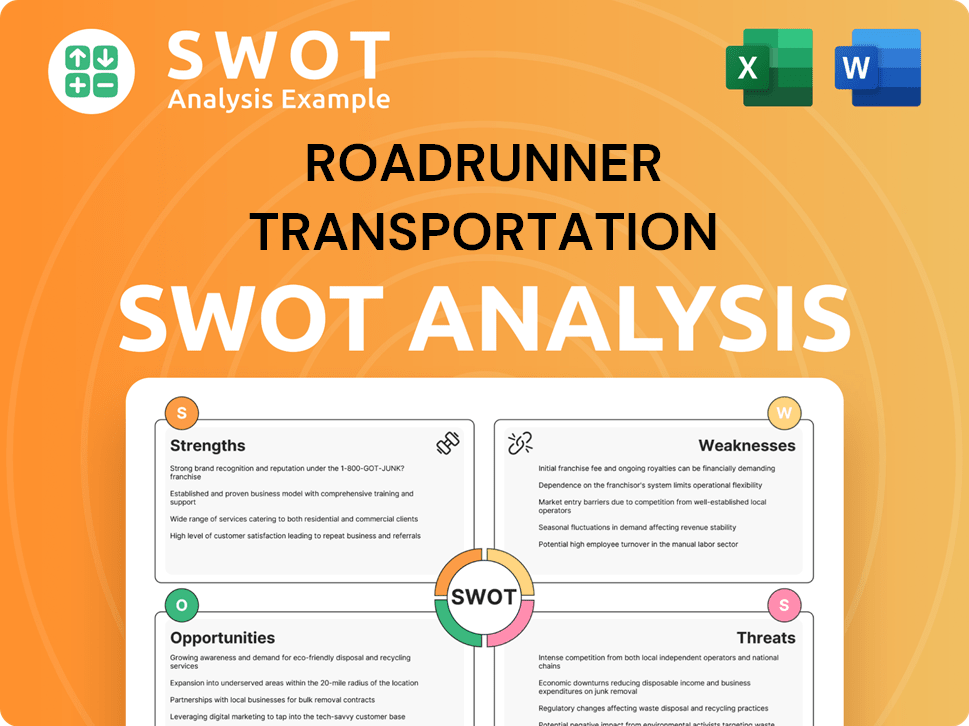
What Do Roadrunner Transportation’s Customers Want?
For Roadrunner Transportation Company, understanding customer needs and preferences is crucial for success. The company's focus on direct, long-haul, metro-to-metro shipping directly addresses key customer priorities. These priorities include speed, reliability, and minimizing freight damage, making it a strong player in the shipping company market.
The company's service model directly addresses these concerns by reducing the handling of freight. This approach is particularly beneficial for businesses dealing with time-sensitive or high-value goods. Roadrunner Transportation Company's commitment to on-time performance and service quality has been a key factor in customer satisfaction since 2020.
Customers are increasingly influenced by on-time performance and service quality. Roadrunner has prioritized these aspects since 2020, leading to positive shifts in customer perception. This focus is reflected in the company's investment in innovative technologies and tailored solutions.
Customers of Roadrunner Transportation Company prioritize speed, reliability, and minimal freight damage. These are the core needs that drive their choices in the logistics sector. The company's direct shipping model directly addresses these needs.
On-time performance and service quality are key decision-making criteria for customers. Roadrunner's focus on these areas since 2020 has significantly improved customer perception. This emphasis has led to increased customer satisfaction.
Roadrunner leverages innovative technologies like AI and machine learning. These technologies provide real-time tracking and enhanced shipment visibility for customers. This helps to improve the customer experience.
The company offers tailored solutions such as Guaranteed Service in select lanes. This provides a full refund for late deliveries, ensuring accountability. This directly addresses customer needs for assurance.
Roadrunner provides boot camp training for its internal teams. This helps to differentiate its value proposition and support both existing and prospective customers. This enhances customer support.
In 2024, Roadrunner achieved the highest jump in Net Promoter Score (NPS) and Customer Value Index score. This was the highest jump of any company as ranked by Mastio, an industry operational audit and reputation survey. This indicates a significant improvement in customer satisfaction.
The company's success in meeting customer needs is reflected in its market performance. For a deeper dive into Roadrunner's strategic moves, consider reading about the Growth Strategy of Roadrunner Transportation. This article provides additional insights into the company's strategies and market positioning, which are crucial for understanding its customer-centric approach and the overall target market.
Roadrunner's customers prefer speed, reliability, and minimal freight damage. The company's services are designed to meet these preferences, leading to higher customer satisfaction. Understanding these preferences is crucial for Roadrunner's market analysis and customer acquisition strategy.
- Speed: Customers want fast transit times, which Roadrunner achieves through direct shipping.
- Reliability: On-time delivery and consistent service quality are essential.
- Minimized Damage: Reducing freight handling lowers the risk of damage.
- Technology: Real-time tracking and visibility enhance the customer experience.
- Accountability: Guaranteed Service options provide assurance and refunds for late deliveries.
Roadrunner Transportation PESTLE Analysis
- Covers All 6 PESTLE Categories
- No Research Needed – Save Hours of Work
- Built by Experts, Trusted by Consultants
- Instant Download, Ready to Use
- 100% Editable, Fully Customizable
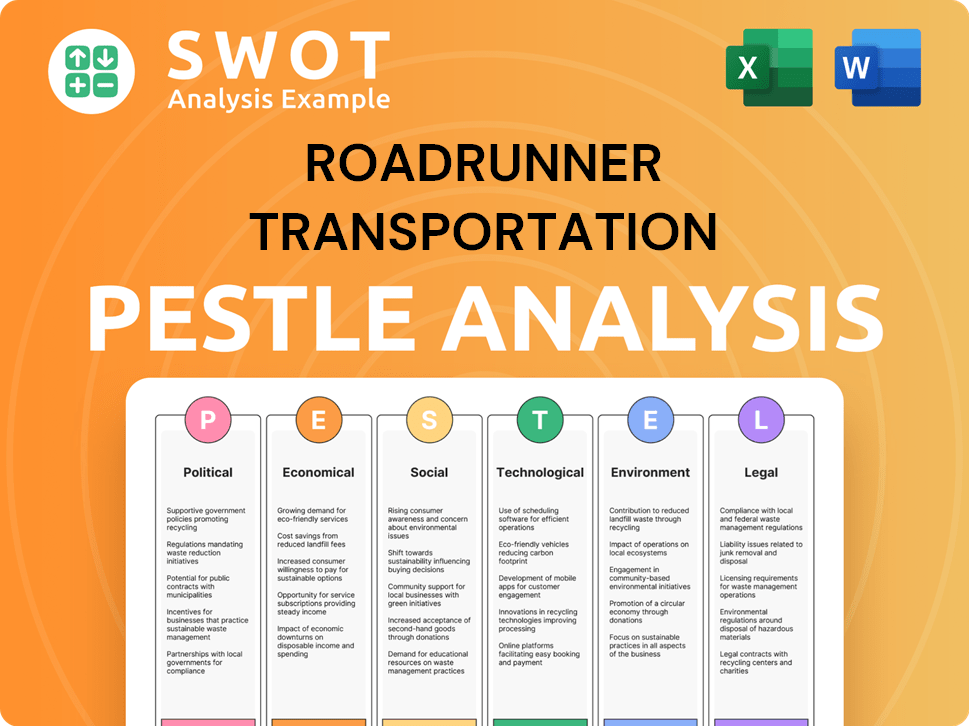
Where does Roadrunner Transportation operate?
The geographical market presence of Roadrunner Transportation Company is substantial, primarily focusing on direct, metro-to-metro long-haul Less-than-Truckload (LTL) services across North America. The company has established a nationwide footprint, with terminals in over 40 metro markets within the United States. Roadrunner's network includes over 100 pickup and delivery partners and 21 physical service locations in the U.S., supported by strategic rail partnerships.
Roadrunner has been actively expanding its network to strengthen its market share and brand recognition. This includes launching LTL services in new locations and extending its reach into major Canadian cities. The company's strategic expansions have been ongoing in 2024 and 2025, introducing new routes and enhancing existing ones to improve service coverage.
The company's expansion strategy includes direct services from key cities, such as Dallas and Houston to Denver, and connections from Tennessee to Denver. They have also enhanced services to Alaska and Hawaii. By August 2024, Roadrunner expanded its Canadian LTL service to include Vancouver, Calgary, and Edmonton. Furthermore, in May 2025, Roadrunner added 18 new inbound LTL lanes into Richmond, VA, from various major U.S. cities. These expansions demonstrate Roadrunner's commitment to strengthening its direct metro-to-metro network, which is a key aspect of its Competitors Landscape of Roadrunner Transportation.
Roadrunner has consistently expanded its service lanes to meet growing customer needs. This includes adding new routes and enhancing existing ones to improve coverage and service offerings. The expansion strategy is designed to strengthen its direct metro-to-metro network across North America.
North America was the largest region in the road freight transport market in 2024. The market is expected to grow significantly, indicating a favorable environment for Roadrunner's continued expansion. This growth supports the company's strategic investments in its network.
Recent enhancements include improved quote automation and transit times for services to Alaska and Hawaii. These improvements are part of Roadrunner's ongoing efforts to enhance customer experience and operational efficiency. The company is also adding new lanes to increase its service offerings.
Roadrunner Transportation Business Model Canvas
- Complete 9-Block Business Model Canvas
- Effortlessly Communicate Your Business Strategy
- Investor-Ready BMC Format
- 100% Editable and Customizable
- Clear and Structured Layout
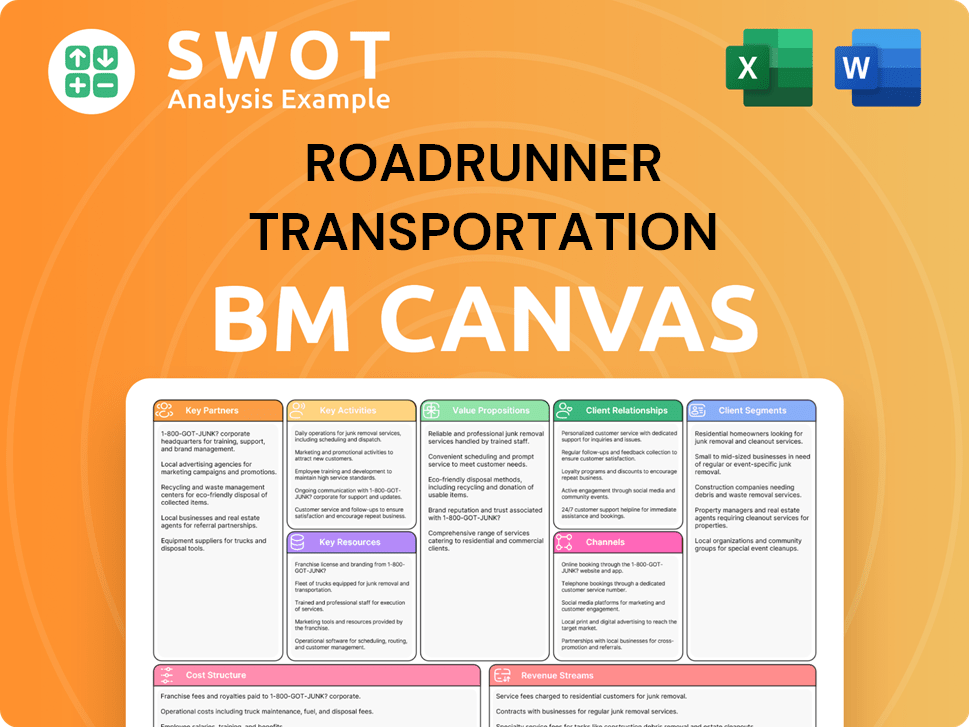
How Does Roadrunner Transportation Win & Keep Customers?
Roadrunner Transportation Company focuses heavily on customer acquisition and retention by emphasizing service quality and technological innovation. Their strategy, particularly since 2020, has revolved around providing on-time deliveries and superior service. This approach has significantly improved customer satisfaction, as demonstrated by their 2024 performance.
The company leverages its 'Smart Network' powered by AI and machine learning for enhanced customer experience. This technological integration provides real-time tracking and visibility, a key selling point for attracting new customers. The direct routing model eliminates rehandles, reducing the risk of loss or damage, which is crucial for customer retention.
Marketing efforts highlight Roadrunner's 'direct metro-to-metro' long-haul LTL services, targeting shippers seeking reliable freight movement. Awards and recognition, such as the Platinum LTL Carrier Award, are used to build trust and credibility. Furthermore, they are investing in their internal teams through comprehensive boot camp training programs, designed to effectively differentiate the Roadrunner value proposition to both existing and prospective customers.
Roadrunner's commitment to superior service quality and on-time delivery is a cornerstone of their acquisition and retention strategy. This focus has led to improved customer satisfaction metrics, making them a preferred choice in the shipping industry. The company's dedication to service excellence is a major driver for acquiring and keeping customers.
The 'Smart Network' powered by AI and machine learning offers real-time tracking and enhances the customer experience. This technology gives Roadrunner a competitive edge, ensuring the integrity of custodial controls of freight. The advanced technology is a significant selling point for attracting new customers.
Roadrunner's direct routing model, which eliminates rehandles, reduces the risk of loss or damage, which is crucial for customer retention. Their direct metro-to-metro services are designed to meet the needs of shippers seeking quick and reliable freight movement, which expands their customer base.
Roadrunner uses marketing channels to emphasize its strengths, such as direct long-haul LTL services. Awards and recognition from shippers, like the Platinum LTL Carrier Award, are used to build trust. This helps in positioning the company as a leader in the industry.
Roadrunner Transportation Company's success in customer acquisition and retention is driven by a combination of excellent service, technological innovation, and strategic marketing. These elements work together to create a positive customer experience and build long-term relationships. To learn more about their growth strategy, read Growth Strategy of Roadrunner Transportation.
- Prioritizing on-time delivery and superior service quality to improve customer satisfaction.
- Utilizing a 'Smart Network' with AI and machine learning for real-time tracking and enhanced customer experience.
- Focusing on direct metro-to-metro services to meet the needs of shippers seeking quick and reliable freight movement.
- Leveraging awards and recognition to build trust and credibility in the market.
- Investing in internal teams through comprehensive training programs to differentiate the value proposition.
Roadrunner Transportation Porter's Five Forces Analysis
- Covers All 5 Competitive Forces in Detail
- Structured for Consultants, Students, and Founders
- 100% Editable in Microsoft Word & Excel
- Instant Digital Download – Use Immediately
- Compatible with Mac & PC – Fully Unlocked
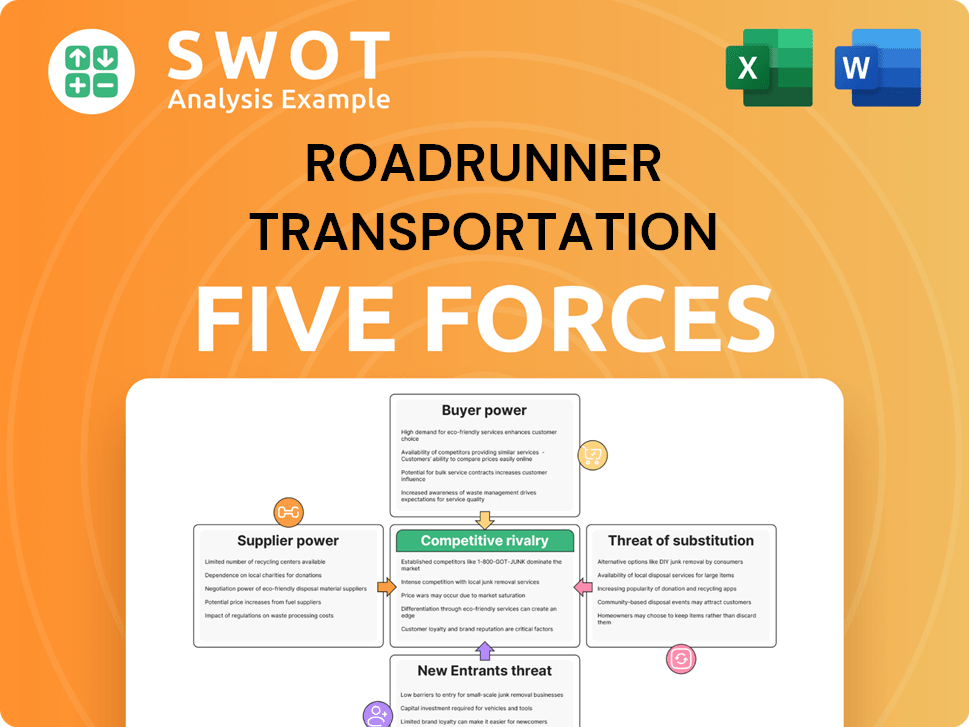
Related Blogs
- What are Mission Vision & Core Values of Roadrunner Transportation Company?
- What is Competitive Landscape of Roadrunner Transportation Company?
- What is Growth Strategy and Future Prospects of Roadrunner Transportation Company?
- How Does Roadrunner Transportation Company Work?
- What is Sales and Marketing Strategy of Roadrunner Transportation Company?
- What is Brief History of Roadrunner Transportation Company?
- Who Owns Roadrunner Transportation Company?
Disclaimer
All information, articles, and product details provided on this website are for general informational and educational purposes only. We do not claim any ownership over, nor do we intend to infringe upon, any trademarks, copyrights, logos, brand names, or other intellectual property mentioned or depicted on this site. Such intellectual property remains the property of its respective owners, and any references here are made solely for identification or informational purposes, without implying any affiliation, endorsement, or partnership.
We make no representations or warranties, express or implied, regarding the accuracy, completeness, or suitability of any content or products presented. Nothing on this website should be construed as legal, tax, investment, financial, medical, or other professional advice. In addition, no part of this site—including articles or product references—constitutes a solicitation, recommendation, endorsement, advertisement, or offer to buy or sell any securities, franchises, or other financial instruments, particularly in jurisdictions where such activity would be unlawful.
All content is of a general nature and may not address the specific circumstances of any individual or entity. It is not a substitute for professional advice or services. Any actions you take based on the information provided here are strictly at your own risk. You accept full responsibility for any decisions or outcomes arising from your use of this website and agree to release us from any liability in connection with your use of, or reliance upon, the content or products found herein.